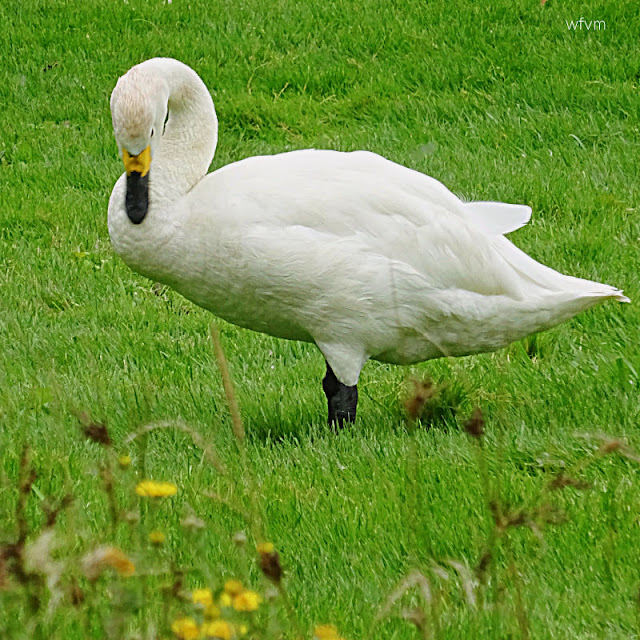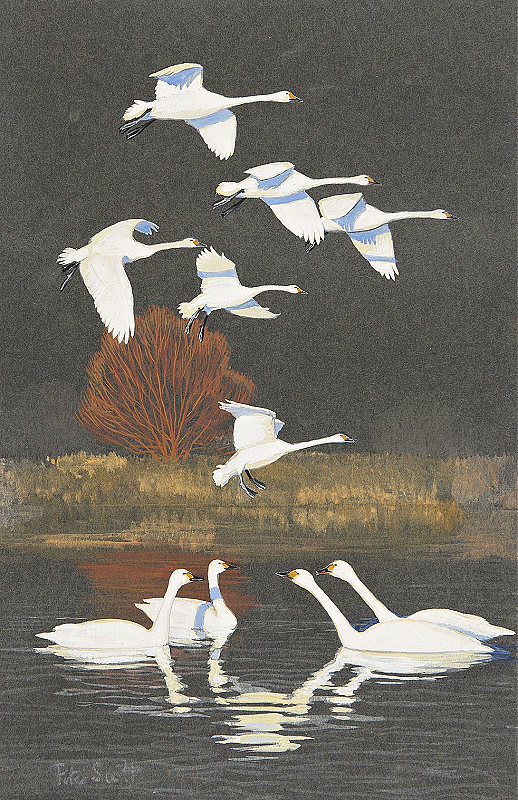Early in the morning the following day we visited Slimbridge WWT founded by Sir Peter Scott, only child of Antartic explorer Robert Falcon Scott.
My
husband met Peter Scott in the 1970s. They were both attending a
conference in Jeddah, Saudia Arabia, drawing up a convention for the
protection of the Red Sea. Scott was representing the International
Union for Conservation of Nature, and they shared a car and driver for
the duration. In every spare moment Scott worked in his sketchbook
recording the beautiful fishes and birds that he saw whilst visiting the different locations. The Saudi hosts were fascinated, as was my husband. He was a
very modest and unassuming character and fun to be with.
Greater Flamingo - Phoenicopterus roseus is
the largest of all the flamingo family. It is found in Africa, India,
the Middle East, and Southern Europe. When we drove through the Camargue several years ago we saw a large flock of these flamingos. When they took to the air, I remember thinking how much they resembled Dyson vacum cleaners!
There are six
different species of Flamingo at Slimbridge. A
pair of Orinoco Geese from S. America. I assumed that this was a couple
of males preening one another, but in fact these geese are momomorphic -
the males and the females look the same.Cranes - Grus grus
Cranes
were wide spread in the Uk upto 1600 but they were sadly driven into
extinction through wetland damage and hunting for food. Now, happily,
they are a great success story. Flocks of them can now be found breeding
across several areas of the country including N.E Scotland.
⭑⭑⭑⭑⭑⭑⭑⭑⭑⭑⭑⭑⭑⭑⭑
If you would like to read the start of a success story from Slimbridge regarding the small Spoon-billed Sandpiper please read here. I wrote about its threatened demise 9 years ago.
⭑⭑⭑⭑⭑⭑⭑⭑⭑⭑⭑⭑⭑⭑⭑
Eurasian Spoonbills Platalea leucorodia
Avocet - Recurvirostra avosetta
The
number of birds to be seen at Slimbridge could fill a book. The previous post
began with our own familiar British Mute Swan, so I will conclude with a
glide pass of four other species of swan. There are only 7 species of swan and the two I have left out are Whopper swans, who have yet to arrive for the winter at Slimbridge, and the Trumpeter swan from North America.
This
swan comes from South America. It is the smallest swan in the world and
is often mistaken for a goose with its short neck and waxy red duck
bill.
This swan is really cute with its red bill and matching pair of red legs and feet.
The Black Swan - Cygnus atratus is
a large swan which breeds mainly in the SE & SW regions of
Australia. With its black, almost velvet like plumage, red bill with a pale bar and tip,
greyish/black legs and feet it is a handsome bird.
The Black Neck Swan - Cygnus melancoryphus is
the largest native waterfowl in S. America. It has a large red knob at the
base of the bill and white stripes running behind the eyes. My husband saw a
group of these in a lagoon in Tierra del Fuego alongside a flock of Chilean
Flamingos. They were in a dramatic snowy landscape with a backdrop of the Andes - a sight that he will never forget.
Two species of swan come to the UK each winter: whooper swans migrate
from Iceland and Bewick's swans make the journey from Siberia. They both have yellow and black bills and can be difficult to separate. Bewick's swans have more black on their yellow-and-black bill than the Whooper swans, and are the smallest swan species to visit the UK.
Every autumn, Bewick’s swans face a dangerous migration to the UK from
northern Russia. Along their 3,500km route between the breeding and
wintering sites there are predators, fewer wetlands and the risk of hitting power lines, but if they don’t
migrate, they will be caught in the ice and snow of an arctic winter. In spring, they do it all again when they fly back to Russia. It is of great concern that
the rapidly changing climate of the Arctic will affect them. Hopefully by late October early November at least 200 Bewick's Swans will have arrived back at Slimbridge for the winter.
Bewick's Swans by Floodlight -
Sir Peter Scott
Bewick's Swans are named after Thomas Bewick (1753 - 1828) the English wood-engraver and natural history author.















Thanks for this outstanding collection of bird portraits, Rosemary. I envy your husband's personal relationship with Peter Scott; it must have been fascinating to share close quarters with him in this manner. I have visited Slimbridge and it is a fine institution. A great deal of important captive breeding of endangered species has been done there. If ever I return to the UK I will make it a point to go there again.
ReplyDeleteIf you ever do have a chance to return to the UK David then you must let us know.
DeleteSir Peter Scott looks like a lovely man in his sculpture, and what a wonderful place he has established. I just looked up Slimbridge because I would love to visit if we ever get back to England - to my delight, it was opened in the month of my birthday, a perfect reason to visit if one was needed. I love your bird pictures, especially the swans, and am very taken with the little swan with red accessories. Scott's picture of Bewick's Swans by Floodlight is stunning. Thank you for a beautiful post.
ReplyDeleteThe little S. American swan was so small and its feathers looked really soft and downy - I am really pleased that you enjoyed the post Patricia - thank you very much.
DeleteSuch beautiful birds. And so many kinds of swans!
ReplyDeleteJust two swans missing from this collection Debra.
DeleteDearest Rosemary,
ReplyDeleteSome majestic water fowl captured on camera!
Our https://animalia.bio/american-flamingo are just a little bit smaller than the Phoenicopterus roseus species you mention here above. We see them frequently in Florida and it is amazing that they reach an age of around 40-60 years! Always found them, together with the Swans one of the most elegant water fowl.
As for Cranes, as a little girl back in The Netherlands, we heard them so often overhead when they flew over and always loudly talking. Here I only once heard them but was too late for catching it on camera.
Great post as usual.
Hugs,
Mariette
Dear Mariette - the American flamingo is closely related to the Phoenicopterus roseus flamingos and also the Chilean Flamingos. They had them a Slimbridge, and I have seen them too in Florida.
DeleteThank you for your very generous comment which I greatly appreciate.
🦩🦩
DeleteYour photos are all so excellent, and I really appreciate learning about these birds. What a wonderful place to visit! Thanks for sharing with me!
ReplyDeleteDear Barbara - I am pleased that you enjoyed learning about these birds. I don't consider myself to be very skilled at capturing birds so your comment is very much appreciated.
DeleteHello Rosemary, You saw your share of unusual birds that day. Bewick's Birds is a famous book even in America. I don't know if I have mentioned it, but Taiwan is considered a great place for birding--apparently it is on many migration routes, and offers a resting place. Almost any place with some sort of pond or water has tons of bird life, even in Taipei City itself.
ReplyDelete--Jim
Hello Jim - I didn't realise that Taiwan had so many migratory birds, but I am not surprised. The example I mentioned in the link of the small Spoon-billed Sandpiper travels all of the way from the far eastern Tundra of Russia to Myanmar and Bangladesh. On the way it passes through the world's industrial powerhouses – Japan, China and South Korea.
DeleteSmashing clear photos as usual. Shows how old some of the landscape names are. Up here there's a hill of the elk and a crane loch near Edinburgh. I've always toyed with the idea of a large long range camera with professional zoom for capturing wildlife in greater detail then dismissed it as it commits you to a certain type of photography. Hides, long waits, endless patience etc and at heart I'm an opportunist, see it,capture it immediately, move on quickly type. It's the walk that's still the main event when I'm outdoors.
ReplyDeleteI have also though of having a camera with a better lense, but they are too bulky. I like the one that I have as it fits snuggly in my pocket - its being out of doors for me too and whatever happens to catch my eye.
DeleteAs always, wonderful photos. The flamingos reminded me of doing an "exchange" in 1959. V. came and stayed with my family in Surrey and then he and I travelled by boat and train to St. Remy de Provence. His father was the Headmaster so was on holiday and I was taken all around the area.
ReplyDeleteI am so pleased that this post brough back some old memories for you.
DeleteOh I loved this post, especially the picture of the small swan with the bright red bill. The older I get the more I enjoying spotting birds. Maybe I have slowed down enough to finally noticed them?
ReplyDeleteI am so pleased that you enjoyed seeing this post Janey - thank you.
DeleteRosemary these birds are a delight to see….just love the flamingo.
ReplyDeleteThank you Margaret - close up the flamingo is really unusual looking.
DeleteWe are so used to what we see often, and have no idea about other birds. I see the black swan regularly, but the pink flamingo looks like an artist's dream.
ReplyDeleteManaging to get a really close image of the Flamingo does reveal their astonishing features.
DeleteHi Mum, I enjoyed your 2 posts covering our visit. If only we could have captured a photo of the kingfisher. Love, Youngest Son
ReplyDeleteThat would have been fantastic 'YS'. It would, however, be way beyond my camera's capacity to capture a Kingfisher, but I know that you could with yours. Glad that you enjoyed the two posts - we loved having you both💚
DeleteLOVELY post and a swan with a red bill! Wow! Always great photos on your blog...
ReplyDeleteLove, Titti
Thanks Titti - It is interesting to see how very different swans around the world areX
DeleteThanks for that post, Rosemary. When I was a little boy my mother used to take my brother and I to Peakirk, near Peterborough, another collection of birds assembled by Sir Peter, though it closed long ago now. At least we still have the WWT reserve at Welney to visit. I wonder if that's where the picture of the floodlit swans was painted.
ReplyDeleteI had assumed that he had done it at Slimbridge, but I don't know the answer, so you could be correct.
DeleteHello, Rosemary, I’m back. Each and every bird here is photogenic, but I love best the tender, affectionate pose of Orinoco Geese you captured. Japan’s red-crown crane was also on the verge of extinction bur has recovered its numbers thanks to active conservation actions.
ReplyDeleteYoko